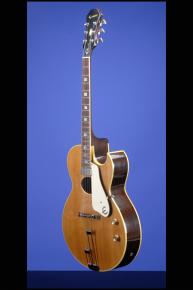"Sweet and Lowdown"
This rare guitar, with a Natural spruce top, was owned by jazz guitarist Howard Alden, and was used to teach Sean Penn how to play guitar for his leading role in the movie "Sweet and Lowdown." The guitar weighs just 5.60 lbs. and has a single-Florentine cutaway 'shallow' archtop body with a natural spruce top and an oval soundhole and mahogany back and sides. Single-piece mahogany neck with a medium-to-thin profile and a nut width of just over 1 5/8 inches. Rosewood fretboard, expertly refretted (for Howard Alden) with 20 medium jumbo frets and pearl block inlays with slotted-sides. The body is triple-bound (white/black/white) on the top and single-bound on the back, the soundhole is single-bound, and the fretboard is single-bound. Headstock in inlaid pearl "Epiphone" script logo and pearl cloud inlay. Epiphone stylized "E" engraved on truss-rod cover. Individual Grover Roto-Matic tuners with bell-shaped metal buttons. Single 'Johnny Smith' style floating mini-humbucker pickup with an output of 6.88k. Four-layer (white/black/white/black) plastic pickguard with Epiphone stylized "E" onlaid in silver and black. Two controls (one volume, one tone) on lower treble bout. Gold plastic bell-shaped knobs with metal tops. Rosewood bridge with pre-set compensating saddle and Frequensator tailpiece. All hardware chrome-plated. This guitar has been expertly refretted (for Howard Alden) with medium-jumbo frets. Apart from one or two extremely minor surface scratches on the back of guitar and a little bit of finish checking, this guitar is in near mint (9.25) condition. Housed in the original Gibson black hardshell case with orange plush lining (8.75). Complete with a letter of authenticity from Howard Alden.
Howard Roberts was an innovator and guitar designer in addition to being an astonishing player. By the mid sixties he began developing a series of unique instruments, some of which remain available to the present day. The trend began in 1961 when Howard was approached by Les Prop, an exec at CMI (Chicago Musical Instruments, a company which controlled both Gibson and Epiphone), to design an Epiphone signature model. The result was the Epiphone Howard Roberts model. Co-designed by Andy Nelson, this namesake guitar was introduced on Capitol's Something's Cookin' album, recorded in July-August of 1964. The Epiphone Howard Roberts was essentially a Gibson ES-175 upgraded to better wood, equipped with a single floating mini-humbucking pickup mounted at the end of the fingerboard, and an oval soundhole instead of the traditional f-holes. It was offered in both Standard and Custom models.
"In 1964 Howard Roberts joined Epi with a unique, oval-hole archtop electric with a floating, Johnny Smith-style pickup. The oval hole was Roberts' idea. He liked to hear his guitar acoustically, even though he was playing it amplified, but on a conventional f-hole archtop, the pickguard covered up one soundhole and the player's arm covered the other. The oval hole solved his problem. A fancier, gold-plated version was added in 1965 and christened the Howard Roberts Custom." (Walter Carter. Epiphone. The Complete History, p.68).
This guitar was owned by jazz guitarist Howard Alden, with a letter of authenticity signed by him. "The Epiphone Howard Roberts you now have was purchased by me in 1992 from Bruce Gittleman, a guitar dealer in Los Angeles at that time...I was traveling quite a bit, so I had it shipped to a friend in San Francisco, as I figured I would use it the next time I played in the Bay area...In May 1995 Jimmy Bruno, Frank Vignola and myself recorded the CD entitled The Concord Jazz Guitar Collective...For a few of the selections an electric guitar would get a better blend...so Frank used the Epiphone on a few tunes. Once again I had my hands full, so I left it again with my friend in San Francisco. In May of 1998 I was called upon to teach Sean Penn to play guitar for his role in the Woody Allen film eventually entitled 'Sweet and Lowdown'. I was in Sacramento playing at a Jazz festival, and Sean...wanted to start working right away, so I spent a couple of days in San Francisco getting him started, and took him the HR guitar to get something in his hands immediately. A few weeks later we acquired the Dupont Maccaferri style guitar that he used in the film, but for the first few weeks he learned and practiced on the Epiphone. After he was done with it I took it back to New York."
Translate:









